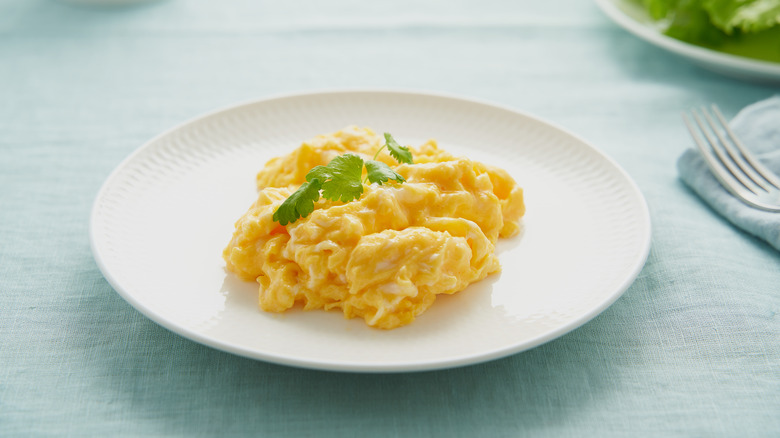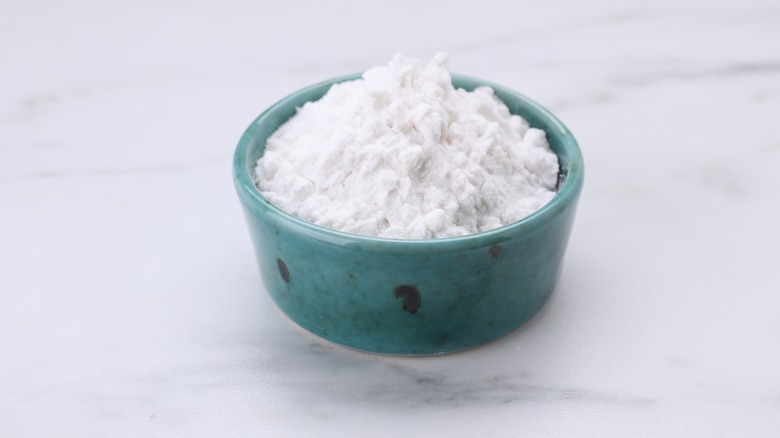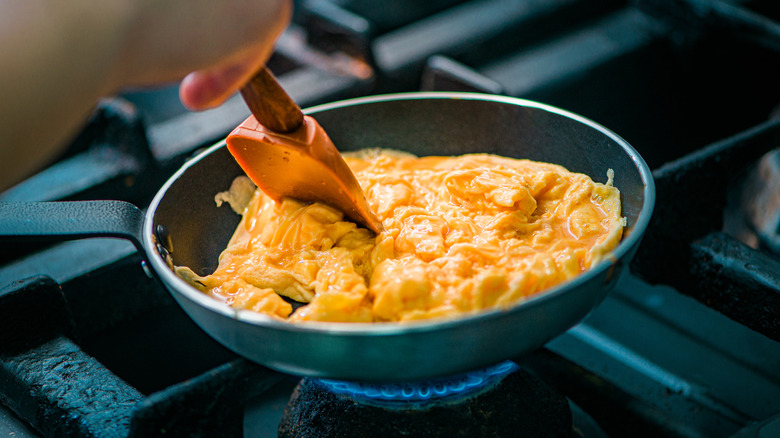Why Cornstarch Is Key To Making Your Scrambled Eggs Better
Texture can make or break your scrambled eggs. While the ideal plate might be full of custardy eggs, a watery mouthfeel is not pleasant. Add too much liquid, cook on too high a heat, or use older eggs, you may find your breakfast is more soup than solid. Fortunately, adding a little cornstarch can help to thicken things up and give you a dreamy, creamy consistency.
However, you don't want to simply add a spoonful of raw cornstarch to your eggs — it will get clumpy, and no one wants a mouthful of starch. The general rule of thumb is to make a slurry to incorporate the starch a little more easily. This is done by combining equal amounts of water and cornstarch, then whisking it all together until it's smooth. It may seem counterintuitive to add extra liquid to firm things up, but it prevents lumps in your breakfast.
Use about one teaspoon each of cornstarch and water mixed per every two eggs you cook. The slurry should be added before cooking, so the cornstarch has time to activate — it gels between 144 to 180 degrees Fahrenheit. The increased temperature is one caveat since cooking low and slow is one key to making restaurant-quality scrambled eggs.
Fortunately, the addition helps to prevent the protein from drying out if you have to turn up the heat. Cornstarch is flavorless, so it won't impact the taste of your scrambled eggs at all; it'll just improve the texture of the final dish.
How does cornstarch work?
Cornstarch thickens the foods it's added to through the process of gelatinization. The powder is made of two different starch molecules: Amylose and amylopectin. It contains around 25% amylose, which means it will gel up and thicker more than other types of starches.
In addition to making a slurry, you may need to add a little extra heat for the cornstarch to work its magic. — so you may have to cook your eggs just a little bit hotter. The added moisture and increased temperature allow the molecular bond to break down.
Amylose and amylopectin are released into the water when heated, and the molecules reform into a new structure as the starches cool off. That new bond will create a thicker texture gradually, adding more stability to the dish. So if you're craving some restaurant-quality scrambled eggs at home, adding a little bit of cornstarch in may just be the key.
Substitutes for cornstarch
If you don't have cornstarch on hand, potato or tapioca starch can work as a one-to-one swap. Both function similarly in terms of thickening properties, and both are mildly flavored. These should also be made into a slurry, and then added to the whisked eggs prior to cooking. However, the starches activate at different temperatures.
Both potato and tapioca starch require slightly lower temperatures than cornstarch. Tapioca starts gelling between 126 to 150 degrees Fahrenheit while potato starch is 136 to 150. So if you prefer to cook your eggs low and slow until they reach that perfectly silky, custardy consistency, these may be a better swap.
In a pinch, a great substitute for cornstarch may already be in your pantry: all-purpose flour. Instead of making a slurry with water, however, you'll want to melt down some butter and whisk the flour in to make a roux. You can even keep all the cooking in one pan by pouring the eggs over the prepared roux.
This may add in an extra dose of richness as it thickens the breakfast protein. The eggs will take on a little extra oomph from the melted butter. The roux may become a little toasty and nutty if left on the heat to brown before mixing in the eggs, bringing that nuttiness to the finished dish.



